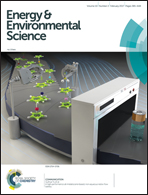The structural origin of enhanced piezoelectric performance and stability in lead free ceramics†
Abstract
Lead-based piezoelectric materials are currently facing global restrictions due to their lead toxicity. Thus it is urgent to develop lead-free substitutes with high piezoelectricity and temperature stability, among which, potassium-sodium niobate [(K,Na)NbO3, KNN] has the most potential. It is very difficult to simultaneously achieve high piezoelectric performance and reliable stability in KNN-based systems. In particular, the structural/physical origin for their high piezoelectricity is still unclear, which hinders property optimization. Here we report the achievement of high temperature stability (less than 10% variation for electric field-induced strain from 27 °C to 80 °C), good fatigue properties (stable up to 106 cycles) as well as an enhanced piezoelectric coefficient (d33) of 525 pC N−1 in (1 − x)(K1−yNay)(Nb1−zSbz)O3–xBi0.5(Na1−wKw)0.5HfO3 (KNNS–BNKH) ceramics through manipulating the rhombohedral–tetragonal (R–T) phase boundary. The structural origin of their high piezoelectric performance can be attributed to a hierarchical nanodomain architecture, where the local structure inside nanodomains comprises R and T nanotwins. The physical origin can be attributed to low domain wall energy and nearly vanishing polarization anisotropy, facilitating easy polarization rotation among different states. We believe that the new breakthrough will open a window for the practical applications of KNN-based ceramics.



 Please wait while we load your content...
Please wait while we load your content...